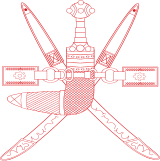
Back الإمبراطورية العمانية Arabic Imperio omaní Spanish امپراتوری عمان Persian Empire d'Oman French Օմանի կայսրություն Armenian Kekaisaran Oman ID Impero omanita Italian オマーン帝国 Japanese A̱byintyokshan Oman KCG 오만 제국 Korean
Omani Empire | |||||||||||||
|---|---|---|---|---|---|---|---|---|---|---|---|---|---|
| 1696–1856 | |||||||||||||
 Chronological map of the Omani Empire and Zanzibar | |||||||||||||
| Capital | |||||||||||||
| Common languages | Official: Arabic Regional: Balochi Persian Swahili English French Malagasy | ||||||||||||
| Religion | Dominant: Ibadi Islam Minor: Sunni Islam Shia Islam Christianity | ||||||||||||
| Demonym(s) | Omani | ||||||||||||
| Government | Monarchy | ||||||||||||
| Yaruba Dynasty | |||||||||||||
• 1692–1711 | Saif bin Sultan (first) | ||||||||||||
• 1711–1718 | Sultan bin Saif II | ||||||||||||
• 1718–1719 | Saif bin Sultan II | ||||||||||||
• 1719–1720 | Muhanna bin Sultan | ||||||||||||
• 1722–1723 | Ya'arab bin Bel'arab | ||||||||||||
• 1724–1728 | Muhammad bin Nasir | ||||||||||||
• 1742–1743 | Sultan bin Murshid | ||||||||||||
• 1743–1749 | Bal'arab bin Himyar | ||||||||||||
| Al Busaid Dynasty | |||||||||||||
• 1744–1778 | Ahmad bin Said | ||||||||||||
• 1778–1783 | Said bin Ahmed | ||||||||||||
• 1783–1793 | Hamad bin Said | ||||||||||||
• 1792–1804 | Sultan bin Ahmed | ||||||||||||
• 1805–1806 | Badr bin Seif | ||||||||||||
• 1806–1856 | Said bin Sultan (last) | ||||||||||||
| History | |||||||||||||
| 1696 | |||||||||||||
• Civil war in Oman | 1718 | ||||||||||||
• Persian invasion of Sohar | 1742 | ||||||||||||
• Al Busaid Dynasty took over | 1749 | ||||||||||||
• Treaty with the United States | 1837 | ||||||||||||
| 1856 | |||||||||||||
| Population | |||||||||||||
• 1870 estimate | 367,400[1] | ||||||||||||
| Currency | |||||||||||||
| |||||||||||||
The Omani Empire (Arabic: الْإِمْبَرَاطُورِيَّة الْعُمَانِيَّة) was a maritime empire, vying with Portugal and Britain for trade and influence in the Persian Gulf and Indian Ocean. After rising as a regional player in the 18th century, the empire at its peak in the 19th century saw its influence or control extend across the Strait of Hormuz to modern-day Iran and Pakistan, and as far south as Cape Delgado. After the death of Said bin Sultan in 1856 the empire was divided between his sons into two sultanates, an African section (Sultanate of Zanzibar) ruled by Majid bin Said and an Asian section (Sultanate of Muscat and Oman) ruled by Thuwaini bin Said.
- ^ "Population: Oman", Maddison Project Database, version 2020. Bolt, Jutta and Jan Luiten van Zanden (2020), “Maddison style estimates of the evolution of the world economy. A new 2020 update ”. Archived from the original on 22 March 2022.

